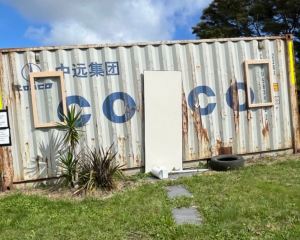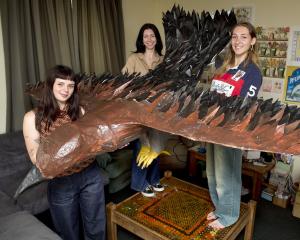Imagine a day when all major languages can be written in all scripts, American translingual poet Assoc Prof Jonathan Stalling says.
"I believe we will be able to move beyond and between our languages more freely, intuitively and effectively as soon as we start using different writing systems to bridge languages rather than imagining them as walls between them.''
Prof Stalling, from Oklahoma University, visited Dunedin recently to speak about his work to create and propagate a Chinese orthography for writing and learning English, in and through, Chinese characters, a project he calls ''SinoEnglish''. It all began when he started to study Chinese in high school.
"My first Chinese teacher stressed the memorisation of classical Chinese poetry through my high school years."
His love of languages and poetry arose in middle school where he wrote his first collection of poetry - he called it Social Corruption and other Miscellaneous Round Fruit.
He went on to write a few serious poems in high school and was also translating classical Chinese poetry during this time.
"Growing up with back-to-the-land artists as parents, I had access to a wide bohemian culture that included many artists, poets, and Chinese martial arts was a very important part of my family growing up.''
So despite his family's geographic isolation in the Ozark Mountains of Arkansas, he had an upbringing rich in the arts and counterculture social conditions, he said.
"I suppose I have never really thought of them as being separate. In fact, my first book of poetry Grotto Heaven is a rewriting of my middle school Chinese grammar book, so I suppose you can take this literally.''
Then in his 20s he discovered the recordings of a Chinese professor, the late Parker Huang who was well known for his chanting abilities.
So Prof Stalling began to learn to chant/sing poems in the yinsong style, a practice which has become nearly extinct in China. While recordings are hard to come by, he had the chance to learn from living practitioners.
"I like to sing/chant classical poems as a part of my poetic and teaching practices as I believe it is important for people to come into contact with the tradition's aural, embodied dimensions.''
"This is important because in the West many have come to value classical Chinese poetry only for what is taken to be its imagistic nature, which is an impoverished view.''
All of his work had been affected by the practice at some level as he had become increasingly interested in how people heard sound across different linguistic bodies.
"Poetry provides us a fecund space to explore interlingual listening.''
He developed and taught his first hybrid English-Chinese poetic forms at UC Berkley as an undergraduate student before being asked by his professor to come up with a way of transferring the prosody of Chinese classical poetry into English.
She liked the results so much that she adopted the form in her pedagogy, he said.
"I have gone on to develop these forms over the last two decades and teach all the major modes and genres of classical Chinese using this hybrid English-Chinese form.''
By using principally monosyllabic English - there are at least 3000 words to choose from - one can tonalize the vowels and build any classical Chinese form with English. ''I wanted to bring English into the family of global languages that house classical Chinese poetic forms like SinoKorean, SinoVietnamese, or SinoJapanese.''
"While the English medium for Chinese poetry uses an alphabetic script, rather than Chinese characters, they all compose Chinese poems out of their own speech sounds just encoded within characters. This process of adapting languages to new cultural parameters and structures of feeling generally takes a long time and responds to broad, often even coercive geopolitical forces, but language can be coaxed into changing through experimental art as well.''
"The only question is whether the results of an experiment will have legs; whether the results are able to take on a life of its own within the lives of others.''
In the late 1990s, he began composing Chinese-English homophonic poetry, poems composed in Chinese characters that when read aloud sound like English.
He published he first of these poems in 2002 and called the practice Sinophonic English. A sinophonic English opera, Yingelishi ( which means ''Chanted songs, beautiful poetry''), came next and was staged in 2010 at Yunnan University in China.
In this work, he said, the libretto took the form of a rewritten English phrasebook that taught English through Chinese characters.''
"I simply rewrote all of the Chinese to become more poetic and meaningful in Chinese and directed the work toward a reflection on the nature of this Sinophonic meditation itself.
"I chose to make this work an opera as I believe the sound of the work when performed well can open up new cultural networks of feeling the world's largest interlangauge in a way no longer haunted by the vestiges of yellow-face minstrelsy but on its own terms.''
After Yingelishi, he began to get questions from Chinese students who were using his opera to learn English. His interaction with those students and teachers challenged his assumptions about the relationship between innovative poetics, art, and notions of ''utility''.
"I had believed that art becomes ''non-art'' when it becomes instrumentalised in one way or another. And I still believe this is true as instrumentalisation creates standardized, repeatable processes whereas art moves in the opposite direction.''
However, he had come to a place where he want to run experiments in both directions and so had embarked on something akin to an ''applied poetics'' where a poetic ''practice'' would be embodied in something other than a poem or work of art. ''To follow this shift in mindset through, I went back to study more deeply how the interlanguage innovations that came about at the intersection of Sanskrit and classical Chinese phonetics first emerged and how these innovations changed language consciousness at a larger scale.''
He was inspired by the rime tables and the practices that generated them to reimagine another way to fuse English and Chinese, not at the level of syllables like Yingelishi, but at the level of phonetic DNA. ''You see, for well over 170 years now English is written in Chinese characters where every character is a syllable. Obviously, as a system, this does not work well since English consonant blends and consonant-vowel relationships are different.''
However, this all changed when characters were broken into their consonant and vowel values as they did in the medieval rime tables.
"As it turns out English and Mandarin have almost the same phonetic DNA (phoneme palette) they just had to be rearranged into an English alphabet. I call this new Chinese character English alphabet, SinoEnglish.''
The result of its success in tests created an opportunity to build algorithms that have generated the various software platforms and applications for teaching and learning spoken English more quickly and efficiently.
"Poets and artists can dissolve recalcitrant assumption about languages and cultures as things bound to fixed oppositions. By merging languages like Chinese and English in different ways, I believe we release arbitrarily pent-up sentience so that it may flow more freely within the lingual continuums we all inhabit.''
He believes the word ''languages'' is a shorthand term and that languages are not isolated or ''pure'' in any sense.''
Thus we need not speak of learning in terms of ''mastery'' but should instead think of languages as the direction we face within any given lingual continuum.
Many of his students and friends avoid using limited forms of other languages out of fear that they will mispronounce or ''butcher'' the target language. But this ''all or nothing'' mentality around language learning reinforces the ideological hold of monolingualism and prevents people from getting closer to new coordinates, which only happens by socializing new language skills.
"I envision a world of new interlanguage technologies that help us understand and interact with the space between ''languages'' in more conscious, aware, and sentient ways.''
Experimental poetry or art was an individual pursuit but was born in community, he said.
"It is impossible to overstate how important this is to the life force of language innovation. But I also hope that we can look back on the rime tables as something in between art and technology as they were originally produced by poets and largely used and circulated by them over centuries, but they helped create a paradigmatic shift in the way language (Chinese characters) behaved.''
That art was lost with the importation of Western linguistic technology (letters).
"I believe SinoEnglish, if adopted by users as something useful to them will help bring this phonetic capacity back to Chinese characters.
''I'm not sure if this goal is 'art' but falls somewhere in between.''
It had been difficult to convince the technology and English as a second language world that ''ancient, now obscure poetics'' can become a catalyst for new tools for language learning.
For instance, when he went on a lecture tour in China this summer and presented SinoEnglish to various university audiences across four provinces, he discovered that it was nearly impossible to explain SinoEnglish but instead had to simply teach the system and test audiences in real time. In each case, it took an early adapter in each audience to start yelling out the answers and that act gave permission to everyone in the room to try and people were soon actively trying to use the system.
''I love this aspect of SinoEnglish because it speaks to the strange ways we lock down and open up the ''possible'' through social and behavioural perimeters rather than hard set of inert, concrete rules.''
He was devoting a lot of time to find ways of introducing his work into China.
''Obviously I believe in the work I do, but it is very important not to drink one's own Koolaid to the point where one can no longer interact with the work within critical honesty.''
So it meant testing everything time and again and adapting the work.
''But as an artist to also watch the larger experiment, the one exploring the relationship between various kinds of successes.''
The applied aspects of this work were important and would benefit people in time in their daily lives, he said.
''I hope the art-poetics of the work will find a productive dialogue with others who work within and between languages.''
SinoEnglish introduces a major disruptive technology into a very big industry (English as a foreign language).
''So I expect a more mixed reaction especially for those who hear about SinoEnglish, but have not had a direct experience.''
The next step is to find a way to let as many as possible test it first hand.












